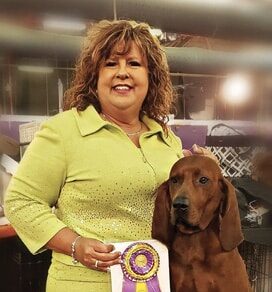When judging and evaluating Redbone Coonhounds, I look for the overall dog. I start at the head and work down over the body to the feet, legs, and tail. I am looking for a nice, houndy head, with a nice ear set; not Bloodhound in type and not high set with a Sporting dog type of ear hang or length.
The standard says it should reach almost to the end of the nose, not to the middle of the cheek. I like it touching the nose in length, proportionate with the dog’s head. A good, dark eye or, in exception, a hazel-colored eye, is usually coordinating with a medium-golden red coat. A darker dog with a lighter eye is not favorable. When looking into a Redbone’s eyes, it is a pleading expression you are looking for. It is usually a look that melts most people’s hearts. (You almost cannot tell them “no” on whatever they are asking for.) A nice, well-balanced head is the first thing you should see in the breed.
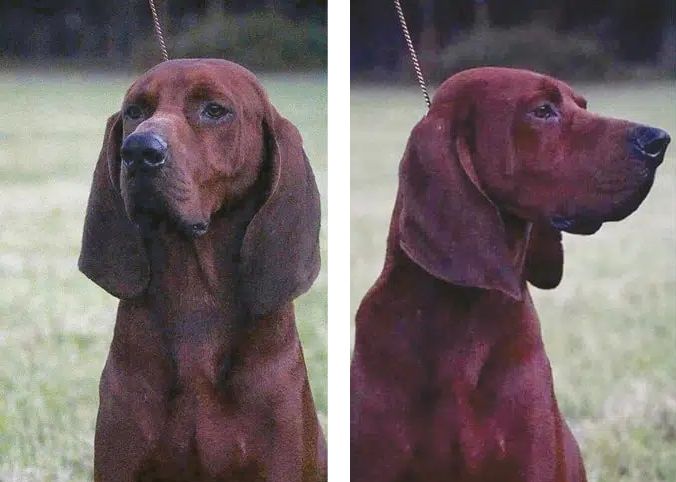
Then, reaching down the neck, it should have a slight arch in it, and the throat should have a slight fold under the jaw. Then onto the back, a nice lay of shoulders and a good spring of rib. Slightly taller at shoulders than the hips… not necessarily seen but felt. A dog should not look like a drag race car running around the ring, or standing still, higher in the rear than the front.
When judging Redbone Coonhounds I look for adequate muscle. Redbones have a leaner, tighter muscle. This varies with dog type, but must be present; not flabby or boney. A nice saber-like tail is free of curl and heavy brush. This is a single-coated breed and has a short length coat with various shades of red, varying from a golden red coat to a dark mahogany coat. Note that the coat changes during the lifespan of the dog. As the dog gets older, the coat starts to get lighter in color, and grey can appear on the muzzle, cheeks, and toes as early as four years of age, much like a Plott graying in the same areas.
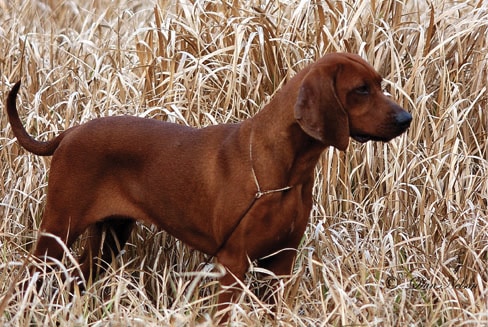
The hindquarters should never be straight or cowhocked, as this doesn’t allow for a free-moving dog, nor should they be over-angulated. The forelegs and pasterns should be straight and the feet well-padded and cat-like, with nice, short toes. Front legs should not toe in or out, but should be straight-on when viewed. Front dewclaws are left on, for another source of grabbing onto the tree while baying (treeing) game. Back dewclaws are a fault; not permissible. Most of the Redbones are also left with some length of nail; not long toe nails, but not nubs. They have a purpose in their hunting.
Redbones have a distinctive, flowing movement. It is deliberate in stride. They are not to be moved and run with like a Sporting dog. The dog is “wind-ing” the air and hunting for game as it is moving through the terrain that includes swamp, rivers, creeks, fields, woods, and mountains. A dog that is running wide-open is most likely overrunning the scent and losing his game trail. In the same terms, a dog that cannot move freely, and have reach and drive, and just pokes along—and is going to have to catch a cab to get to its game because, by now, it is in the next county. These dogs are hunters and should be viewed as such.
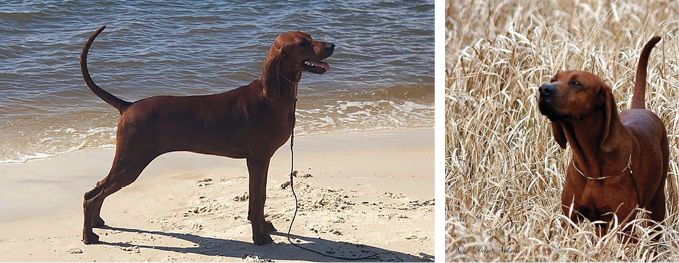
Dogs that are dual-purpose hounds will most likely tote battle scars, pieces of ear missing, split ears, scars on their head or legs, and clouded or blinded eyes. They will also be missing hair sometimes, especially under the chest, from underbrush, and around the throat area from tracking collars and/or multiple collars worn while hunting and training. Also, when the hair grows back, it comes back white in most cases. You can tell the difference between white hairs scantily on the throat from being pulled out or rubbed off and that of being white [markings] up the throat, which is totally different. Being a breeder and hunter, I easily overlook these battle wounds and take them in with admiration.
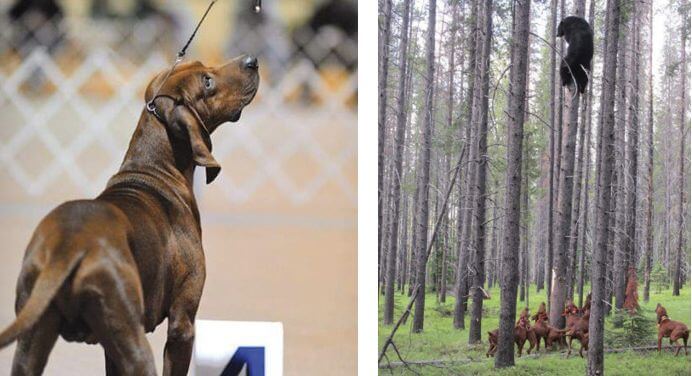
Redbones should give an overall impression of being sound and athletic and judging Redbone Coonhounds should be as a whole package and not a specific color or height. Everything should be in proportion.
The Redbone, when viewed from a distance, should have a distinction in sex also. The bitches and dogs shouldn’t have to have an “undercarriage” check in most cases. The bitch is a little more elegant in most cases and has more tuck-up. She may also not be as heavy in body, but should have enough substance about her to take on her quarry of game.
The dogs in temperament are very even-tempered, but are very aggressive on game. The show ring is tolerated by most. I’m not saying they do not enjoy showing, but most of them come to life when game is present—almost like turning on a light switch.
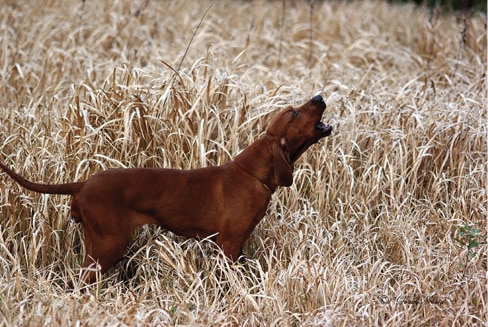
So, when making my choices, I look for the dog that has substance and structure to help denote its ability to do its job, with breed characteristics known only to the Redbone. A 20-pound coon or 500-pound bear or hog can be hunted by the same exact dog, so it has to fit the standard to be able to do its job. They meet their game head-on in most cases. Remember, they do not need to become the prey. But if the tables are turned, Redbones need to be able to stand their own ground.
Redbone Coonhound Dog Breed Magazine
Showsight Magazine is the only publication to offer dedicated Digital Breed Magazines for ALL recognized AKC Breeds.
Read and learn more about the amiable Redbone Coonhound dog breed with articles and information in our Redbone Coonhound Dog Breed Magazine.
Error embedding FlippingBook shortcode, please check the flipbook url. (https://digital.showsightmagazine.com/view/341732/)








